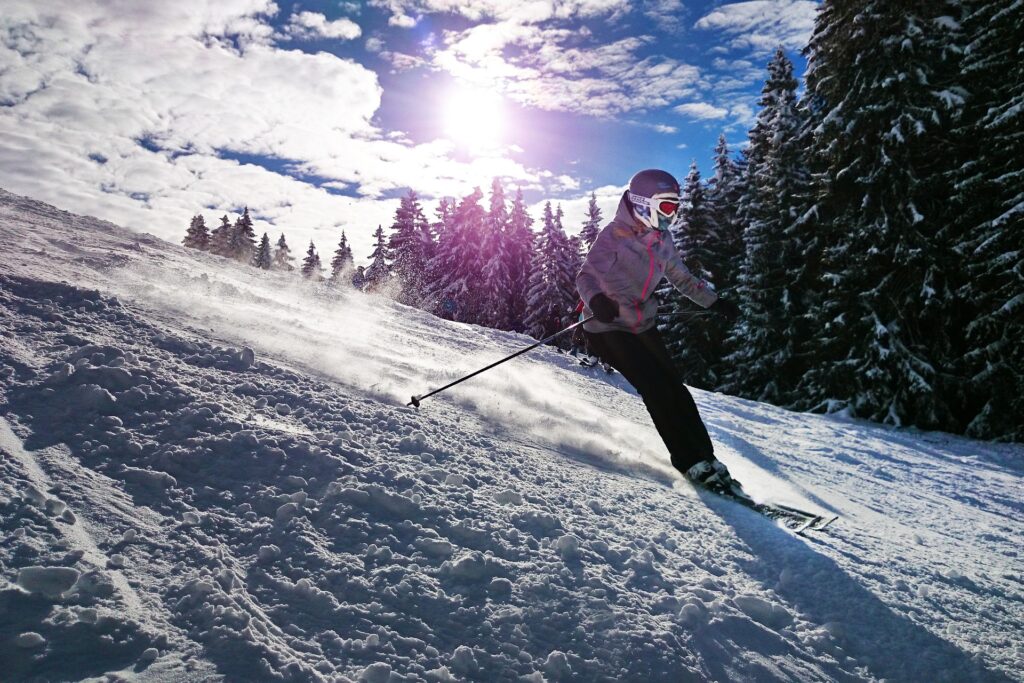When buying all of the ski equipment and clothing you need to get the most out of your trip to the slopes, an incredibly important piece of your ski gear is your ski jacket. Lots of people wonder, do ski jackets really need to be waterproof though?
Here, we will look at what waterproofing actually is, how it protects you on the slopes, and what waterproof ratings really mean.
When looking to buy a new ski jacket, you may come across lots of technical terms as well as different ratings which can be tricky to understand if you’ve never come across them before. Understanding these and knowing what to look for is key in choosing the ski jacket that will be right for you.
So, we have put together a comprehensive list of everything you need to know about waterproof ski jackets.
Here you will find information on how waterproofing can help to keep you warm, what other features of ski jackets to look out for, how the waterproof rating system works and the key question: do ski jackets REALLY need to be waterproof?
Do Ski Jackets Really Need to be Waterproof?
Ski jackets can either be waterproof or water resistant. Waterproof ski jackets are recommended as they prevent snow and water entering the jacket and keep the person warmer. Water resistant ski jackets are less expensive.
So, you might now be wondering exactly why waterproof jackets can keep you warmer, what other features you also need to know about (like breathability!), and how to tell how waterproof any given jacket is!
If you are looking to buy a ski jacket and want to know about waterproofing and its importance, keep reading for everything you need to know!
Conditions on the Ski Slope
When thinking about the exact qualities your ski gear and clothing needs to have, it is first important to consider what conditions you will likely be facing out on the slopes.
This does depend on where, and what time of year you will be skiing. For example, you probably won’t find the same conditions if you are skiing on a dry ski slope in summer, compared to a snowy ski slope during the winter ski season! Therefore, we will focus on the conditions on the slope during the winter ski season out on the snowy piste.
It goes without saying, but the conditions on the slopes are generally very cold with plenty of snow covering the ground, and possibly even snowfall.
This means you can expect your clothing to come into contact with plenty of snow. This means that your clothing on the slopes needs to properly protect you and keep you warm and dry, without inhibiting your ski technique.
Why Waterproofing Helps to Keep You Warm
Waterproofing does just what it says on the tin, it prevents water from passing through the material and getting to your base layers of clothing beneath.
If this snow melts within your jacket, it can make you extremely cold and uncomfortable. Therefore, the primary role of a ski jacket is to keep you warm and also dry.
Therefore, waterproofing as well as insulation is important in keeping you not just dry, but also warm.
Breathability
While it is incredibly important to make sure you stay warm enough out on the slopes, an important thing to also consider is breathability.
Breathability is the ability of the jacket to retain heat, while allowing any perspiration to escape and not all be retained on the inside of your jacket. Skiing is a very active sport, meaning your body will give off heat, especially if warmed by an insulated and waterproof ski jacket as well.
This means that lots of skiers can sweat with the heat that is generated when they ski. This sweat, while being generally uncomfortable to the wearer, also has the potential to condense and cool down against the skin if not able to exit the jacket, which can make the wearer very cold.
Therefore, it is important to look for a breathable and waterproof ski jacket which is also well insulated against the cold conditions. This will allow you to stay warm and dry, while also preventing perspiration build up on the inside of your jacket!

Types of Ski Jacket
Winter Jackets
Winter jackets have the primary function of being incredibly warm when the wearer is out and about in cold conditions. These are not usually designed specifically for skiing, and are less likely to be waterproof or have a high waterproof capability. Many winter jackets are more likely to be weather-resistant instead.
Many people like winter jackets due to the greater range of styles and colours. However, these jackets may not come with many of the specialised features that ski jackets offer, such as ski skirts, being lightweight, flexibility to allow a large range of movement and breathability.
Check out this comparison between ski jackets and winter jackets for more info.
3-in-1 Jackets
3-in-1 jackets combine an outer protective shell layer and an insulating layer underneath. These jackets are often waterproof so be sure to look out for a waterproof rating to make sure that they do indeed have this feature.
These jackets may also have the benefit of being able to remove the underneath insulating layer. This allows a great deal of flexibility built in to one jacket.
Shell Jackets
Shell jackets usually consist of an outer protective layer which can be worn over a more insulating layer of clothing, as shell jackets may not come with an insulation layer themselves. These jackets usually can be categorised as one of two things:
- Softshell
- Hard-shell
Soft-shell jackets usually provide some weather and wind protecting, but are unlikely to be very waterproof if at all. They are designed to be highly breathable and lightweight, meaning you can move very freely while skiing on the slopes.
Hard-shell jackets normally provide more protection from weather and rain than softshell jackets. They are still lightweight and flexible, but are designed with more weatherproofing in mind.
You still need to check if these jackets are actually waterproof speak to a professional about the exact features of any given jacket.
Waterproof Ratings
You can tell how waterproof a ski jacket is by looking at its waterproof rating. This is a general rule for waterproof ski jackets, although this may not be specified on all jackets, and not all ski jackets may be waterproof.
However, if you are able to see the waterproof rating of a jacket, it is good to know exactly what the different numbers mean and which might be right for you!
The waterproof rating is determined by testing materials in a laboratory and the higher the rating, the heavier the rain is able to be before penetrating through the material.
In general, lots of ski jacket waterproof rating will vary between 1,500mm or possibly even lower than this, up to above 20,000mm.
<1,500mm- able to withstand only very light drizzle or spray conditions
1,500- 5,000- these are usually water-resistant and can withstand light showers only.
5,000-10,000- these waterproof jackets may be able to withstand a reasonable level of rain and snow.
10,000- 20,000- these highly waterproof jackets are able to offer protection from much heavier rain and snowy conditions.
>20,000- Extreme waterproofing, these jackets may be able to withstand heavy rain.
Other Important Features
There are other important features of ski jackets to look out for as well as waterproofing. As we discussed above, breathability is an important factor to consider to make sure you stay comfortable out on the slopes.
For similar reasons, lots of ski jackets have ventilation areas on the jacket. These can typically be beneath the arms and allows excess heat and perspiration to escape and not stay inside your ski jacket.
Another important feature of some ski jackets is having elasticated material at the wrists and sometimes also the waist. This creates a tighter seal in areas where snow such as powder could enter the ski jacket as opposed to through the material itself.
Snow skirts are another feature of some ski jackets which may either be integrated into the jacket itself or removable and re-attachable. This extra feature provides extra protection at the bottom of the jacket by providing extra material which can be elasticated.
Conclusion
To conclude, not all ski jackets are waterproof and those that are, are measures in terms of a waterproof rating where a higher rating means it can resist heavier rainfall without letting water penetrate through the fabric.
Waterproofing can help to keep you warm and dry by preventing water from entering the jacket and making your base layer clothing damp and cold. Water entering your jacket can make you very uncomfortable and cold as it cools down close to your skin.
Other features of ski jackets are also important to look out for and can help to keep you warm. Elastic material at the wrists and waist can prevent snow from getting inside your ski jacket, as well as snow skirts providing extra protection.
Features such as breathability and ventilation can also be important features in an active sport such as skiing, to make sure you stay dry and comfortable and to prevent perspiration from staying inside your jacket.
So, there is our guide all about ski jacket waterproofing! If you found this guide useful, be sure to check out our other tips and tricks to make the most out of your trip to the slopes!
